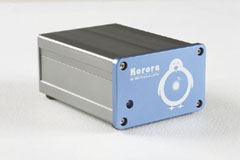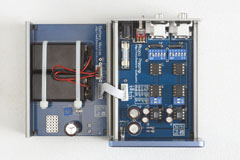You are reading the older HTML site
Positive Feedback
ISSUE
23
january/february
firestone audio
Korora phono stage
as reviewed by Roger Gordon


|
ROGER S. GORDON'S SYSTEM
LOUDSPEAKERS
ELECTRONICS
SOURCES
CABLES ACCESSORIES |
In Issue 22 of Positive Feedback Online, Ed Kobesky reviewed three Firestone Audio products—the Big Joe amp ($200), the Tube Head preamp ($255), and the Korora phono stage ($300). I also had the Korora phono stage in my listening room, and would like to add my listening experience to Ed's.
The Korora is cute but small (4D x 3W x 2H inches), and it only weighs 14 ounces. Because it is so light, the Korora was suspended in the air by my somewhat stiff Audio Magic interconnects. I suppose that is one way to isolate it from everything except airborne vibration. The unit is powered by two 9-volt batteries, which are rechargeable via a wallwart. While it will run with the wallwart plugged in, Firestone Audio claims a signal-to-noise ratio of almost -100dB when it is run on just the batteries, and says that it sounds better that way. I could not measure this, but can confirm that the Korora sounds much better with the wallwart disconnected.
The Korora can be used with either moving magnet or low-output moving coil cartridges. Unscrewing four bolts with the supplied allen wrench allows you to remove the top cover to expose two pairs of dip switches. One pair sets the gain to 51, 54, 58, or 69dB. The 69-dB setting should allow the use of moving coil cartridges with output as low as .11 mv. The other pair of switches allows you to add 220 pF of capacitance, if needed (for moving magnet cartridges), and to set input resistance at 10 ohms, 43 ohms, 100 ohms, or 47K ohms. I set the switches for 69 dB of gain and 47K resistance, since I normally use 62dB of gain and set input resistance via resistors built into my phono cable.
I inserted the Korora into my system and played it for several days to make sure that it was broken in. I recharged the batteries each night. I did not hear any major changes to the sound over that period, so assumed that the unit was broken in. When I began listening critically, I found that the Korora sounded like an exceptional product at its $300 price point. A reality check was in order, so I arranged a phono stage shootout at a friend's house. On the arranged day, I and three audiophile friends listened to a Brinkmann Balance turntable with Graham Phantom tonearm and Shelter 90X cartridge, through an Airtight ATC-2 preamp, Airtight ATM-2 amp, and Avalon Opus Ceramique speakers. The phono stages included the ASR Basis Executive, the E.A.R. 88PB, the E.A.R. 324, the Art Audio Vinyl-1, the Whest, the Eastern Electric MiniMax, the Vacuum State JLTI, and the Korora. By doing A/B comparisons, we arrived at a consensus about the relative ranking of the phono stages.
The shootout revealed that my ears had not deceived me—my friends agreed that the Korora performed far above its price point. Its errors are ones of omission rather than commission. In comparison to its higher-priced brethren, the Korora's soundstage is smaller, it provides less fine detail, and its images are not as three-dimensional. However, it has no discernible colorations and no veiling. Our host summed it up very succinctly when he said that if someone walked in when the Korora was in the system, they would enjoy the music, and not realize what they were missing until one of the high-priced phono stages was substituted.
My ears validated, I returned home and did some more listening to the Korora, and made further comparisons with my Vacuum State JLTI and Herron VTHP-1 phono stages. The JLTI is a solid-state unit with 60dB of gain. The Herron is a tube/solid-state hybrid with the signal from the cartridge increased by 22dB with a FET gain stage before going through the tube circuitry for an additional 40dB. The Herron had just returned from an update at the factory. According to Keith Herron, it needed several hundred hours of break-in, but was sounding very good after only 100 hours, so I felt comfortable comparing it to the Korora.
After matching levels with test tones and a sound pressure meter, I listened to four LP tracks: The Eurhythmics, "Missionary Man," from Revenge (RCA AJLI-5847), Schumann, Piano Concerto, Swarowsky, Vienna State Opera Orchestra (Audio Fidelity FCS 50,015), Louis Armstrong, "St. James Infirmary" (Classic Records 45 rpm reissue), and Jennifer Warnes, "Bird on a Wire," from Famous Blue Raincoat (Cypress Records 661-111-1). First I did A/B comparisons between the Korora and the Herron, then between the Korora and the JLTI. In no area did the Korora exceed either the JLTI or the Herron. I could list all the areas in which the Korora fell short, but I'll just say that for $300, you can't expect the Korora to come close to the Herron or the JLTI (another overachiever at its price). Still, I found it amazing how enjoyable the Korora was, even when compared to these much more expensive units. In direct comparison, the differences were night and day, but if I did not have either the Herron or the JLTI, I would have listened happily through the Korora. There are many more expensive phono stages for which I cannot make that statement. They either add colorations and/or veil the music, which can seriously detract from enjoyment on a high-resolution system.
I would have liked to try the Korora in a modest system. I asked around, but could not find anyone in our local audiophile group with an under-$1500 LP playback system who wanted to A/B phono stages. The two systems in which I heard the Korora are very high-resolution systems that allowed me to hear everything that the Korora did right. Would a more modest system obscure its strengths? Would a colored, veiled phono stage be more euphonic? Though I cannot answer those questions, I am confident that if you are putting together a modest LP playback system and need an outboard phono stage, the Korora should be on your list. It can give much of what a $2000-$3000 phono stage gives, at a fraction of the cost, and as you upgrade your system, it will serve you well until you get into much more expensive components. Roger Gordon
Korora
Retail: $300
Firestone Audio www.firestone-audio.com
US
New York Service Center
Jack Ker
email: [email protected]
